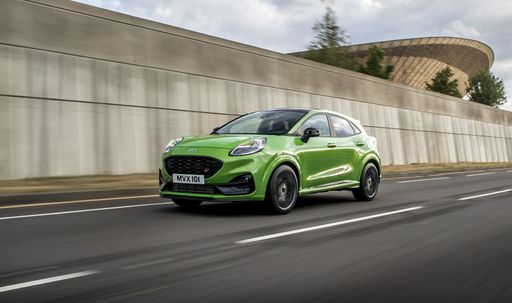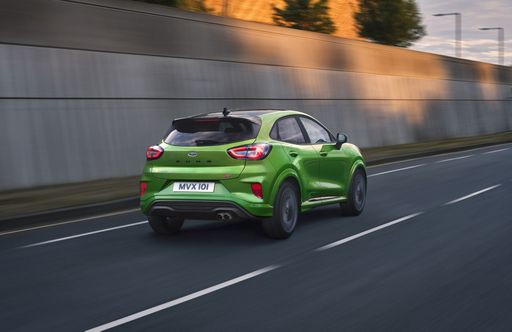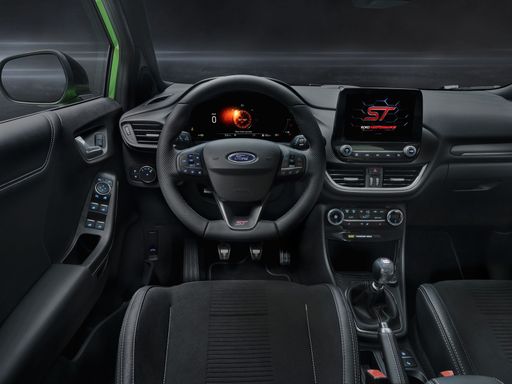Ford Puma vs Toyota Urban Cruiser – Differences & prices compared
Compare performance, boot space, consumption and price in one view.
Find out now: which car is the better choice for you – Ford Puma or Toyota Urban Cruiser?
The Ford Puma (SUV) comes with a Petrol MHEV or Electric engine and Manuel or Automatic transmission. In comparison, the Toyota Urban Cruiser (SUV) features a Electric engine with Automatic transmission.
When it comes to boot capacity, the Ford Puma offers 523 L, while the Toyota Urban Cruiser provides 310 L – depending on how much space you need. If you’re looking for more power, decide whether the 168 HP of the Ford Puma or the 184 HP of the Toyota Urban Cruiser suits your needs better.
In terms of consumption, the values are 13.10 kWh5.40 L per 100 km for the Ford Puma, and 16 kWh for the Toyota Urban Cruiser.
Price-wise, the Ford Puma starts at 24800 £, while the Toyota Urban Cruiser is available from 25700 £. Compare all the details and find out which model fits your lifestyle best!
Ford Puma
The Ford Puma presents itself as a stylish compact SUV with a distinctive design that combines practicality with a dynamic driving experience. Its sleek lines and sporty aesthetics make it stand out on the road, while the interior offers a comfortable and tech-savvy environment. With an emphasis on efficiency and a smooth drive, the Ford Puma is well-suited for both urban commutes and countryside adventures.
details @ puma.fordpresskits.com
@ puma.fordpresskits.com
 @ puma.fordpresskits.com
@ puma.fordpresskits.com
 @ puma.fordpresskits.com
@ puma.fordpresskits.com
 @ puma.fordpresskits.com
@ puma.fordpresskits.com
Toyota Urban Cruiser
The Toyota Urban Cruiser is a compact SUV that offers a blend of style and practicality, making it well-suited for urban living. It captures attention with its bold design, while providing a high driving position that enhances visibility and control on city roads. Inside, the Urban Cruiser offers comfortable seating and a range of features that cater to both driver and passengers, emphasizing convenience and everyday usability.
details

|
|
|
|
|
Costs and Consumption |
|
|---|---|
|
Price
24800 - 36300 £
|
Price
25700 - 36800 £
|
|
Consumption L/100km
5.4 - 6 L
|
Consumption L/100km
-
|
|
Consumption kWh/100km
13.1 - 13.7 kWh
|
Consumption kWh/100km
16 - 18 kWh
|
|
Electric Range
364 - 376 km
|
Electric Range
370 - 420 km
|
|
Battery Capacity
43 kWh
|
Battery Capacity
-
|
|
co2
0 - 136 g/km
|
co2
0 g/km
|
|
Fuel tank capacity
42 L
|
Fuel tank capacity
-
|
Dimensions and Body |
|
|---|---|
|
Body Type
SUV
|
Body Type
SUV
|
|
Seats
5
|
Seats
5
|
|
Doors
5
|
Doors
5
|
|
Curb weight
1316 - 1563 kg
|
Curb weight
1837 - 1972 kg
|
|
Trunk capacity
456 - 523 L
|
Trunk capacity
0 - 310 L
|
|
Length
4186 - 4226 mm
|
Length
4285 mm
|
|
Width
1805 mm
|
Width
1800 mm
|
|
Height
1550 - 1555 mm
|
Height
1635 - 1640 mm
|
|
Payload
367 - 469 kg
|
Payload
-
|
Engine and Performance |
|
|---|---|
|
Engine Type
Petrol MHEV, Electric
|
Engine Type
Electric
|
|
Transmission
Manuel, Automatic
|
Transmission
Automatic
|
|
Transmission Detail
Manual Gearbox, Dual-Clutch Automatic, Reduction Gearbox
|
Transmission Detail
Reduction Gearbox
|
|
Drive Type
Front-Wheel Drive
|
Drive Type
Front-Wheel Drive, All-Wheel Drive
|
|
Power HP
125 - 168 HP
|
Power HP
144 - 184 HP
|
|
Acceleration 0-100km/h
7.4 - 9.8 s
|
Acceleration 0-100km/h
7.4 - 8.7 s
|
|
Max Speed
160 - 210 km/h
|
Max Speed
150 km/h
|
|
Torque
170 - 290 Nm
|
Torque
189 - 307 Nm
|
|
Number of Cylinders
3
|
Number of Cylinders
-
|
|
Power kW
92 - 124 kW
|
Power kW
106 - 135 kW
|
|
Engine capacity
999 cm3
|
Engine capacity
-
|
General |
|
|---|---|
|
Model Year
2024 - 2025
|
Model Year
2025
|
|
CO2 Efficiency Class
D, E, A
|
CO2 Efficiency Class
A
|
|
Brand
Ford
|
Brand
Toyota
|
Ford Puma
A Glimpse into the Ford Puma: Fusing Style with Innovation
The Ford Puma stands as a testament to modern engineering fused with style. This compact SUV is not just about aesthetics but brings to the table an array of technical innovations, topped with the reliability and performance Ford is known for. Let's delve into the technical specifics and innovative features that make the Ford Puma a stellar choice for any car enthusiast.
Powertrains and Performance
The Ford Puma is offered with a range of powertrains designed to deliver optimal performance whilst minimising fuel consumption. At the heart of this compact SUV is the 1.0 EcoBoost Hybrid engine, available in both 125 PS and 155 PS variants. This engine is a marvel of engineering, optimised to deliver power efficiently with a remarkable fuel consumption ranging from 5.4 to 5.7 L/100km for manual versions, and slightly higher for the automated variants.
The top-end 1.5 EcoBoost ST variant takes performance up a notch, providing a robust 200 PS that propels the Puma from 0 to 100 km/h in just 6.7 seconds. This variant is perfect for those who prioritise performance and exhilaration in their driving experience.
Mild-Hybrid Technology
The Puma's mild-hybrid technology plays a significant role in enhancing fuel efficiency and reducing emissions. By utilising a belt-driven integrated starter/generator, the Puma recovers energy usually lost during braking, storing it in a 48-volt lithium-ion battery. This stored energy is then used to assist the engine, providing a boost during acceleration and smoothing out the stop-start technology, ultimately leading to enhanced fuel efficiency.
Design and Comfort
The Ford Puma does not compromise on style and comfort with its ergonomic and stylish design. The SUV is available in multiple trims including the ST-Line, Titanium, and the luxurious Vignale editions, each offering unique aesthetic and technological enhancements. These trim levels provide varied offerings in terms of both exterior styling and interior comfort, ensuring there's a Puma that meets every personal preference.
Inside, the Puma offers a driver-focused cockpit with advanced technological integrations such as the SYNC 3 infotainment system, providing seamless connectivity and intuitive control of the vehicle's numerous technological features.
Safety and Technology
Safety remains paramount, and the Ford Puma is equipped with the latest security and technology features. It boasts the Ford Co-Pilot360 suite which includes adaptive cruise control, pre-collision assist with autonomous emergency braking, and lane-keeping assist, enabling a safer driving experience on both city roads and highways.
Versatility and Practicality
Beyond performance and safety, the Ford Puma shines in its versatility. With a boot capacity of 456 litres, it offers ample space for all sorts of adventures, whether you're heading on a family trip or loading sports equipment. Its innovative MegaBox is an extra storage solution, providing additional space below the boot floor.
The Puma's agile handling, paired with its compact dimensions—spanning a length of 4186 to 4266 mm and a width of 1805 mm—makes it an ideal choice for urban commuting and beyond.
Conclusion
In conclusion, the Ford Puma beautifully blends practical features with cutting-edge technology, offering a package that appeals to both the tech-savvy driver and those seeking comfort and reliability. Its range of innovative features, powerful yet efficient engine options, and a design that is both functional and stylish make it a frontrunner in the compact SUV market.
Whether you're drawn by the efficient mild-hybrid engines or the robust performance of the ST variant, the Ford Puma represents a modern driving experience where innovation meets everyday usability.
Toyota Urban Cruiser
Introducing the Toyota Urban Cruiser: A Modern Marvel in the Electric SUV Market
The all-new Toyota Urban Cruiser is here, and it's turning heads with its sleek design and impressive performance. This SUV is not just about good looks; it packs a punch with innovative technical features and an eco-friendly electric engine. The Urban Cruiser offers a perfect blend of style, comfort, and cutting-edge technology, making it a compelling choice for modern drivers.
Electrifying Performance: Experience the Power
At the heart of the Toyota Urban Cruiser is its powerful electric engine, delivering 144 HP and 106 kW to ensure a smooth and responsive drive. The vehicle's front-wheel-drive system is enhanced by an automatic transmission that provides seamless gear shifts. With a torque of 189 Nm, expect swift acceleration and unparalleled driving dynamics, all while maintaining whisper-quiet operation typical of electric vehicles.
Eco-Friendly Engineering: Embracing the Future
In terms of environmental impact, the Urban Cruiser is a trailblazer. It boasts a CO2 efficiency class of A, emitting 0 g/km of carbon dioxide—making it a champion in Toyota's lineup for eco-conscious drivers. This aspect not only aligns with global sustainability goals but also offers substantial long-term savings on fuel costs.
Space and Comfort: Designed for Everyday Adventures
With a generous length of 4285 mm, a width of 1800 mm, and a height of 1640 mm, the Urban Cruiser offers ample space for passengers and a commanding presence on the road. Its spacious interior can comfortably seat five adults, ensuring that even long journeys are a pleasure. Additionally, the five-door configuration provides easy access and versatility for passengers and cargo alike.
Innovative Technology: Keeping You Connected
The Urban Cruiser isn’t just about physical space and environmental consciousness; it’s also about staying connected. Toyota’s latest infotainment system is integrated into the SUV, providing seamless connectivity options for smartphones and other devices. This ensures that drivers and passengers can enjoy music, navigation, and other apps effortlessly, making every trip both entertaining and efficient.
Conclusion: The Urban Cruiser's Promise
In the rapidly evolving automotive landscape, the Toyota Urban Cruiser stands out as a model of efficiency, style, and forward-thinking design. Whether you're navigating city streets or embarking on a weekend getaway, this SUV is equipped to handle it all with grace and ease. With its commitment to sustainability and a host of technological advancements, the Urban Cruiser is undoubtedly a vehicle built for the future.
As Toyota continues to innovate, models like the Urban Cruiser are paving the way for a cleaner, smarter, and more enjoyable driving experience. It's more than just a car; it's a statement of progress and a promise of adventures yet to come.
Which drive types are available for the Ford Puma?
Available as Front-Wheel Drive.
The prices and data displayed are estimates based on German list prices and may vary by country. This information is not legally binding.
